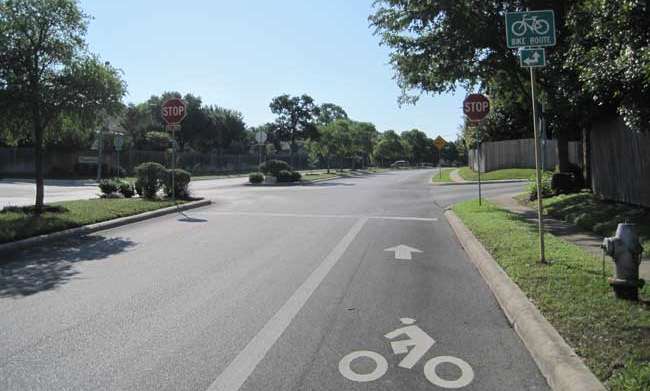Share On Social!
San Antonio pedestrians and cyclists will now have safer streets and walkways thanks to the implementation of the citywide Complete Streets policy. This San Antonio Complete Streets policy has not only helped those living in the city’s Westside, a largely Latino area, but has also paved the way for residents throughout the entire community to gain a better understanding of how an active-living-friendly environment can foster healthier lives.
EMERGENCE
Awareness: Health professionals, including David Clear and Kathy Shields of the San Antonio Metropolitan Health District (Metro Health), were beginning to see that obesity was a problem in the largely Latino city of San Antonio. Along with obesity, many also suffered from diabetes—of these, many were Latino.
In 2004, Metro Health began collecting health data from students enrolled in the area’s public schools. For the first time, measures of obesity, such as body mass index (BMI), were collected as part of this process. The staff at Metro Health discovered that obesity was not only a problem among adults—but there was also a significant prevalence of obesity in children—namely Latino children.
Metro Health found that, of 19,045 children enrolled in the San Antonio Independent School District (SAISD), 29% had a weight categorized as obese. Through the Youth Risk Behavior Surveillance System (YRBSS), they found that, of 1,317 students from eight local high schools, 19.1% were overweight and 20.2% were obese.
“Once we had this data we were a lot more influential,” Shields said.
If nothing was done to curb the obesity epidemic—which contributes to the high rate of chronic diseases in the area—soon children could also be at risk for developing type 2 diabetes. Metro Health found that children attending schools in some of the city’s less affluent neighborhoods suffered from the highest rates of obesity. Of particular concern, were children living on the Westside of the city. In the Westside, 96% of the population was Latino and approximately 33% of residents were living below poverty.
Learn: Shields was initially unfamiliar with the term Complete Streets, and how this type of policy might work to improve the health of the community.
What are Complete Streets?

Source: San Antonio Public Works.
Complete Streets are streets that accommodate the transportation needs of pedestrians, cyclists, motorists, and public transportation users—which can then pave way for both additional recreation opportunities and safer, easier transit to existing recreational facilities.
After recognizing the need that existed on the Westside of San Antonio, officials from Metro Health reached out to the Robert Wood Johnson Foundation (RWJF). It was through the RWJF Healthy Kids, Healthy Communities Program that the city was able to begin to turn things around. The RWJF Healthy Kids, Healthy Communities grant was different from others because it required Metro Health to use an approach that would support policy and environmental changes.
“We started to realize that Complete Streets are…a policy change” for the environment, Clear said.
With a change in mind, health official sought to consult with other city departments.
“The city’s planning department and the health department had been collaborating,” Clear said. “There was capacity on the part of the planning department to know what Complete Streets are—and a willingness [to investigate a change].”
Frame Issue: Metro Health, with aid from the San Antonio Department of Planning & Community Development, decided to include a plan for Complete Streets in their proposal for the RWJF Healthy Kids, Healthy Communities grant. Through the RWJF Healthy Kids, Healthy Communities Initiative and a $15.6 million grant from the Department of Health and Human Services’ (HHS) Communities Putting Prevention to Work (CCPW) program, the staff at Metro Health was able to activate their plan to use a Complete Streets policy as a way to reduce childhood obesity and diabetes in San Antonio.
DEVELOPMENT

Education: To accomplish their goals, the team at Metro Health set up a Complete Streets Working Group.
The Complete Streets Working Group had about 30 stakeholders, including various city departments, such as Public Works, the Office of Sustainability, the Capital Improvements Management Service (CIMS), and the Office of Accessibility. Additional members included the San Antonio-Bexar County Metropolitan Planning Organization (MPO), VIA Transit, the Texas Department of Transportation, CPS Energy, AT&T, and the San Antonio Housing Authority.
“Together we would have a voice that would change the perspective of city officials,” Shields said.
During monthly meetings, members pooled their knowledge on street design, place-making, creating green spaces, transportation, and low-impact development (LID). The MPO happened to be developing a comprehensive Bike Plan, which served as a valuable resource for identifying which streets had bike lanes. A Geographic Information System (GIS) survey of the city’s Westside displayed which streets had sidewalks.
These resources helped the working group identify that there were less than 4 miles of Complete Streets in San Antonio. Members of the group also tuned into webinars and had guest speakers attend some of their monthly meetings, so that they could learn more about Complete Streets.
Once the working group had been established, the City of San Antonio (COSA) Planning and Community Development Department was charged with spearheading the efforts to develop the city’s Complete Streets policy. “Monthly meetings continued and a professional facilitator helped the group run its meetings,” said Marita Roos of the COSA Planning and Community Development Department.

It was the responsibility of the Planning and Community Development Department to see that four main objectives were met: (1) developing a policy; (2) developing tools for implementation; (3) providing training sessions; (4) including community outreach efforts. Initially, four teams were created to address each objective. However, because areas often overlapped, the group decided to work together rather than separately. Individual members often took the lead in furthering the working group’s objectives. For instance, Trish Wallace of the Planning and Community Development Department began to draft the written portion of the policy.
“Our policy was short and sweet,” Wallace said.
Those interested in participating in this process would meet with working group members to provide input.
Mobilization: While the working group was drafting the ordinance for Complete Streets in San Antonio, Metro Health and media outlet NowCast San Antonio enabled residents living on the Westside of San Antonio to identify areas of the community where roads and sidewalks needed improvements. In December 2010, Metro Health and the Planning & Community Development Department conducted three Westside workshops on Complete Streets. This allowed individuals to evaluate their own streets using a mapping tool, and they filmed sidewalks and used Photovoice as a tool to identify poor infrastructure.
Debate: Although, Metro Health and the Planning and Community Development Department would have liked to have formed a coalition of members from the private development community, partners from the working group suggested that this avenue not be pursued because of potential difficulties in getting private developers to buy into the idea of creating Complete Streets.
“Not everyone agreed on everything, we had to think about what would be politically feasible,” Wallace said.
Therefore, they decided to create a Complete Streets policy that would only impact projects undertaken by the city. The group did however still meet with private development groups to discuss their plans to enact this new policy.
ENACTMENT
Activation: The stories of residents were presented at a summit hosted by the COSA Planning & Development Department. The summit helped unite the voices of partners from throughout the community and drew more attention to the need for Complete Streets in San Antonio.
As part of its community outreach efforts, the working group also brought the Better Block Project to demonstrate to the community what a Complete Street should look like.
Frame Policy: With the Complete Streets initiative underway, city officials such as Mayor Julian Castro began supporting the need to make active transportation a priority in the community. As part of his 10-year plan for the City of San Antonio (SA 2020), the mayor called for tripling the miles of Complete Streets in San Antonio.
Members from the Complete Streets Working Group shared their policy drafts with individual city council members, the Real Estate Council, and a group of engineers in private practice. Doing this allowed the working group to learn of any concerns council members had, and how the proposed ordinance might have to be altered—prior to a decision by the San Antonio City Council. This process also allowed the working group to identify members of the City Council who could serve as “champions” for the policy, as well as those who might be opposed the policy.
Two weeks prior to the expected City Council vote date, members of the working group met with the City Council for a “B-session.” At this private meeting, they presented the ordinance and answered questions from Council members.
Change: On Sept. 29, 2011, the Metropolitan Health Department, the Planning and Community Development Department, and its partners witnessed the City Council vote to pass the Complete Streets Ordinance for the City of San Antonio.
“It really comes down to health, safety, quality of life, and economic development,” Roos said of the policy.
IMPLEMENTATION
Implementation: Prior to the passage of a Complete Streets policy and the formation of the working group, there was no one to oversee or evaluate whether projects were meeting any standards to promote an environment of active living. Since the passing of the Complete Streets Ordinance, the city has made progress toward creating a more walkable community.
“Complete Streets is reinforcing the active living concept,” Wallace said. “Evolution of the process is a success in itself.”
The needs of pedestrians, bikers, and motorists, of all ages and backgrounds are now considered during the street planning design, construction, and maintenance process.
In 2012, Complete Street principles were applied to the city’s 2012-2017 bond projects, an endeavor that will allocate $337.44 million in funds to streets, bridges, and sidewalks.
To ensure implementation, leaders who were involved in developing the Complete Streets Policy provided a continuing education course on overcoming the design and constructability challenges that come with this policy change.
One of the implementation tools acquired during the Complete Streets development process was software that traffic engineers can use to evaluate the impact of traffic flow and to incorporate transportation routes for pedestrians and cyclists.
Equity: Further work and continued advocacy is still needed to ensure that Complete Streets are brought to all parts of San Antonio. Although the Complete Streets Working Group no longer meets, a result of the partnership was the formation of a group from the San Antonio Capital Improvements Management Services (CIMS) that provides recommendations guided by Complete Street principles.
“Complete Streets are a requirement in the Capital Improvements Design Guidance Manual, which is a set of standards that governs construction of city improvements to the built environment,” Roos said.
Not only are bond projects following Complete Streets guidelines, but now enhancement projects are also being developed as Complete Streets.
“Members from the City Council are starting to ask for enhancement projects and not all of these are from the bond,” Wallace said. “The city will have to determine where funds for these projects will come from.”
For instance, the Cincinnati enhancement project has just been presented at a public meeting. Enhancements to Cincinnati Street would include landscaping, lighting, and bike lanes to make active forms of transportation more viable in the area.
Sustainability: Ultimately, modifying the city’s unified development code (UDC) would be the best way to ensure that developers from the private sector hold to Complete Street standards when proposing new projects throughout the city. While the Complete Streets policy has brought about many positive changes to the city, the ordinance can only be enforced upon public city projects. Still, cities like the City of Houston are now following suit by developing their own Complete Streets Ordinance. San Antonio is now listed as one of the nation’s fittest cities, a ranking San Antonio city officials and residents are proud of.
Additional Links:
Click here to view one of the HKHC presentations given at the American Planning Association.
Learn more about Complete Streets by clicking here.
See how San Antonio’s policy ranks compared to other Complete Streets in this Policy Analysis.
This success story was produced by Salud America! with support from the Robert Wood Johnson Foundation.
The stories are intended for educational and informative purposes. References to specific policymakers, individuals, schools, policies, or companies have been included solely to advance these purposes and do not constitute an endorsement, sponsorship, or recommendation. Stories are based on and told by real community members and are the opinions and views of the individuals whose stories are told. Organization and activities described were not supported by Salud America! or the Robert Wood Johnson Foundation and do not necessarily represent the views of Salud America! or the Robert Wood Johnson Foundation.
ABOUT THE PROGRAM
Salud America! The RWJF Research Network to Prevent Obesity Among Latino Children is a national program of the Robert Wood Johnson Foundation. The program aims to educate researchers, decision-makers, community leaders, and the public in contributing toward healthier Latino communities and seeking environmental and policy solutions to the epidemic of Latino childhood obesity. The network is directed by the Institute for Health Promotion Research at the University of Texas Health Science Center at San Antonio.
For more information, visit http://www.salud-america.org.
By The Numbers
1
Supermarket
for every Latino neighborhood, compared to 3 for every non-Latino neighborhood
This success story was produced by Salud America! with support from the Robert Wood Johnson Foundation.
The stories are intended for educational and informative purposes. References to specific policymakers, individuals, schools, policies, or companies have been included solely to advance these purposes and do not constitute an endorsement, sponsorship, or recommendation. Stories are based on and told by real community members and are the opinions and views of the individuals whose stories are told. Organization and activities described were not supported by Salud America! or the Robert Wood Johnson Foundation and do not necessarily represent the views of Salud America! or the Robert Wood Johnson Foundation.



